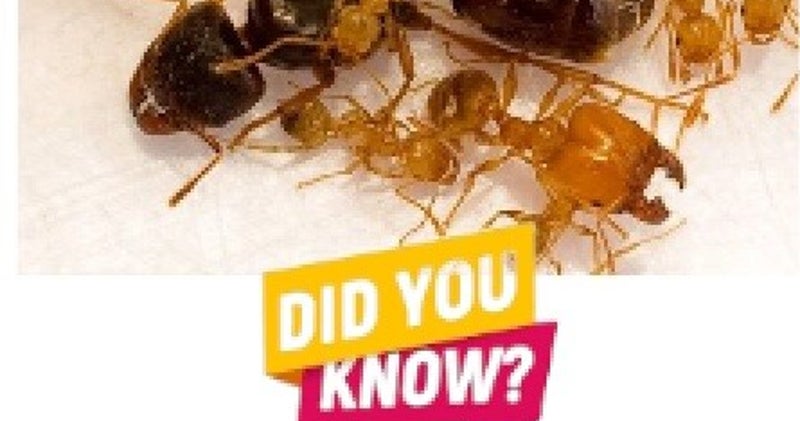
Which names are often used and useful to know.
1. What is an ant gyne and where does the name come from?
An ant gyne (or queen) is the reproductive female in a colony of ants. The gyne is responsible for laying eggs and continuing the colony.
The term "gyne" comes from the Greek word "gynaika", meaning woman or female. This term is often used in biology to denote female organisms or organs. In ants and other social insects, the gyne is the only female in the colony to reproduce. The gyne is usually larger than the other ants in the colony and often has wings that allow it to fly out and establish a new colony.
The term "ant gyne" is often used to refer to the reproductive ant queen, but it can also refer to other females in the colony responsible for laying eggs, such as the secondary queens found in some ant species.
What is an ant worker and what is its function?
An ant worker is a female ant in a colony that has no reproductive functions and focuses on performing other tasks that are essential to the functioning of the colony. Workers are generally smaller than the reproductive females (queens and sometimes males) in the colony and lack wings.
Workers' duties vary according to their age and the needs of the colony, but include:
- Collect food and water
- Taking care of the larvae and the queen
- Build and maintain the nest
- Defend the nest against intruders
- Cleaning the nest and removing waste
- Regulating the temperature in the nest
- Communicate with other ants in the colony
Workers are essential to the functioning of an ant colony, as they work collectively and perform tasks necessary to maintain and grow the colony. Because workers have no reproductive functions, they depend on the queen to lay eggs and produce new ants to keep the colony going.
How does a queen's gaster work and where does the name come from?
A queen's gaster is the abdomen, which is often larger than that of the workers and males. The gaster is important to the queen because it is where the eggs are produced and stored. In addition, the queen can secrete pheromones with her gaster, with which she can influence the other ants in the colony.
The name "gaster" comes from the Greek word for "belly" or "stomach". It is a term commonly used in myrmecology (the scientific study of ants) to refer to the abdomen of ants. The term is also used for other insects, such as bees and wasps.
What are gamergates in ant colonies
Gamergates are adult workers in ant colonies that have developed into reproductive females capable of laying eggs. This occurs in colonies where the queen is absent or ineffective, such as when the queen has died or is too old to reproduce. In these situations, some workers may develop their reproductive organs and begin laying eggs. These workers are called gamergates.
Gamergates can often be recognized by their enlarged gaster (abdomen) and reduced aggression towards other workers. However, they are unable to perform all the tasks of a queen, such as secreting certain pheromones and taking care of the young larvae. Gamergates are therefore not as successful as true queens, and their offspring often have a lower survival rate than that of a colony with a true queen.
How do ants breathe?
Ants breathe through small openings on the sides of their bodies called spiracula. These spiracula are connected to a network of tubes called tracheae that carry oxygen directly to the ant's body cells. The tracheal system is similar to the insect respiratory system in general.
The tracheae of ants branch throughout the body, allowing oxygen to be supplied to all cells of the body. Because the tracheae carry oxygen directly to the cells, ants do not need lungs or blood vessels to carry oxygen as mammals do.
An interesting fact is that some ant species can survive in very low oxygen environments, such as underground or in nests deep in trees. This is because their tracheae are very efficient at taking in oxygen, allowing them to survive in conditions that would be uninhabitable for other animals.
Do ants have blood?
No, ants don't have blood like mammals do. Instead, they have a colorless fluid called hemolymph, which is similar to the blood of invertebrates such as insects and crustaceans.
The hemolymph of ants has several functions in the body, including transporting nutrients, wastes and hormones, and playing a role in defense against disease and infection. Hemolymph circulates through an open circulatory system and flows freely within the body cavity (the hemocoel).
Unlike mammalian blood, ant hemolymph does not contain red blood cells or hemoglobin, which are responsible for transporting oxygen. Instead, ants' body cells receive oxygen directly through the tracheal system, which carries oxygen directly to the cells.
How deep in the ground can an ant live?
The maximum depth at which ants can live depends on several factors, including the species of ant, the availability of food and water, and the properties of the soil.
Some ant species are able to live deep in the ground, to a depth of up to 2-3 meters. These ants have adapted to life underground and are able to survive the lack of light and oxygen. They also have special features that help them survive, such as large jaws for digging through soil and soil, and special hairs that protect them from drying out.
However, other ant species live mainly on the surface of the soil and only dig shallow nests. These ants depend on the availability of light, air and water and are unable to live deep in the soil.
In general, ants can survive at different depths depending on their adaptability and resource availability.

